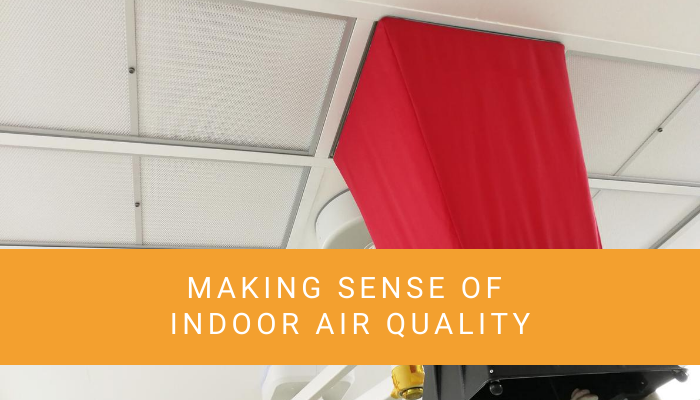You've probably been hearing a lot lately on the topic of Indoor Air Quality (IAQ). And for good reason, recently a group of employees at Epic Systems to the tune of 89% of the employees expressing dissatisfaction with Epic's return to work strategy.
One of the key factors of a building that is perceived healthy is indoor air quality. But what is indoor air quality? SBA has compiled the guide to teach you what you need to know about IAQ.
Table of Contents
-
What Indoor Air Quality is
-
Why IAQ matters
-
How to implement IAQ improvement strategies
-
The Drawbacks of improving Indoor Air Quality
-
Creating your own pandemic mode
-
Conclusion
What is Indoor Air Quality (IAQ)?
Indoor air quality is both a quantitative and qualitative measure of the quality of air within the built environment.
I use the words quantitative and qualitative because while IAQ can be measured against quantitative measures like particulate count, O2 levels, etc the effect of those measures are still very much qualitative when it comes to viral mitigation.
Depending on which studies you read you will get recommendations spanning from simply improving filtration to the utilization of 100% outdoor air with zero re-circulation. As with anything in life the answer seems to largely reside in the middle.
Why does IAQ Matter?
IAQ matters because the science shows that certain data marks will impact the health of building occupants. Those marks, regardless of the virus, are CO2 from the human respiratory process, CO from combustion processes, Volatile Organic Compounds (VOC), and outdoor air CFM/person or square foot.
As you can see there are a lot of variables to IAQ. The reason that IAQ matters is both scientific and psychological.
Scientifically controlling the IAQ measures I mentioned earlier will improve the health of your building occupants. The jury is still out as to which IAQ measures combat pathogens but there is solid since that IAQ measures like VOC, CO2, and O2 control improve occupant health.
There is also the psychological aspect of IAQ. People are scared, they may live with at risk family members and it is concerning that they may be exposed to pathogens in their place of work. It is my personal belief that this fear will not disappear after the current crisis has subsided. I believe that IAQ will be an expected deliverable by building occupants and we will see government regulations around IAQ enter the building codes.
How do you Implement IAQ IMPROVEMENT Strategies?
When it comes to improving IAQ there are two main strategies. You can improve IAQ through specialized technologies or through sequence of operations changes.
Here is a good video by ASHRAE that describes some of the IAQ strategies that we will discuss below.
Technologies for IAQ Improvement
The three primary technologies for IAQ improvement are:
While each of these technologies have impact on IAQ they often tend to work best when combined in some particular format.
Needlepoint Bipolar Ionization (NPBI)
NPBI is a technology that ionizes the air steam. These ions then attach to pathogens and kill the pathogens by starving them of hydrogen. The nice aspect of this technology is that it can deal with high-velocity air streams which is one of the recommended sequences for pathogen control. It is worth noting that some solutions based on ionization do produce ozone.
Here is a video on NPBI.
UV Light Treatment
UV Light treatment works by using light across the Ultraviolet spectrum to kill pathogens. The downside of UV lighting is that it usually requires a period of exposure in order to sterilize the objects. Because of this UV light treatment is usually used for static objects like coils or for spot sterilization of objects within spaces.
Here is are two videos that explain how UV sterilization works.
HEPA, MERV-13 FILTRATION
HEPA filters with a rating of MERV-13 or higher are proven to reduce viral loads in the air steam. The problem with using HEPA filtration has to do with pressure drops. As the airflow is impeded by the filters the fan systems have to work harder to maintain discharge static pressure. This results in increased fan energy and ultimately reduces the total CFM capacity of the air-side systems.
Here is a video that explains pressure drop.
Sequences for IAQ Improvement
There are several recommendations for sequencing our HVAC systems in order to improve IAQ.
The recommendations mainly fall into four categories:
- Increasing Outside Airflow
- Increasing Air Changes
- Increasing/Controlling Humidity
- Building Flush and Exhaust Flow Strategies
Increasing Outside Airflow
Increasing the amount of outside air entering the building is one of the primary recommendations for reducing the viral load within a building. According to ASHRAE you should, "close return air dampers and open outdoor air dampers to 100% or to the maximum setting that the HVAC system can accommodate and still maintain acceptable indoor conditions."
The benefit of this strategy is introducing more fresh air into the building. The downside of this strategy is the increased load on the system to maintain indoor air temperature and humidity.
Increasing Air Changes
Another recommend strategy is to increase air changes. A air change is defined as a complete change in the cubic volume of air within a space. Traditionally air changes are controlled via the supply and the exhaust rates of a space. Therefore ASHRAE recommends either changing the discharge air temperature to increase the supply flow of terminal units (thus increasing air changes) or changing the exhaust rate therefore increasing air changes.
Here is a quick video discussing air changes.
Increasing/Controlling Humidity
It is believed that the amount of moisture in the air stream impacts how far viral particulates can spread. The belief is that humidity ranges between 40 to 60% RH causes the viral droplets to loose their moisture and increase their salt content. This is believed to inactivate viruses in the air.Because of this you are seeing recommended humidity ranges of up to 60% RH and no lower than 40% RH.
Remember that more moisture will be contained in higher dry-bulb air then in lower dry-bulb air.
Here is a video that discusses the effect of humidity on viruses in the air stream.
Building Flush and Exhaust Flow Strategies
One of the final strategies is that of the building flush and constant exhaust flow.
In order to maintain the ideal IAQ conditions within a building ASHRAE recommends implementing a building flush for two hours prior to occupancy and for two hours post occupancy. In addition to this it is recommended that exhaust systems per permanently enabled in spaces that typically have poor circulation, common areas, restrooms, elevator lobbies, etc.
The theory is that by maintaining airflow and air changes you will reduce the impact of viruses in the air stream.
Here is a video that dives deeper into some airflow and pressurization concepts that you should know.
What are the Impacts of Improving IAQ?
We would be remiss to not discuss how these new IAQ strategies would impact buildings. As with anything in life there is an effect to any cause.
When you begin to implement these sequences you will experience the following effects:
- Increased utility spend
- Increased maintenance
- Decreased equipment life
- Initial Cost for implementation
Increased utility spend
If you increase your airflow or increase your outside airflow you will naturally have increased utility costs. This stems from the increase of fan utilization and the increase in cooling/heating loads. Ideally you will focus on airflow first as those loads can be localized to the spaces that are occupied whereas increased cooling/heating loads tend to have a system wide impact.
Increased maintenance
If you are running your systems "harder" or "longer" then you will naturally need to perform more preventative maintenance on the equipment.
Decreased Equipment Life
As your equipment runs more it will naturally have less running hours left. This means that older equipment may need to be budgeted for replacement and may fail sooner than expected.
Initial Cost for implementation
There is a cost associated with implementing any of these strategies. I discuss how to implement these strategies in our two part podcast series, you can listen to part 1 and part 2 below.
Conclusion
I hope this guide helped you better understand the options and strategies available to you. If you have any questions please ask them in the comments below.





